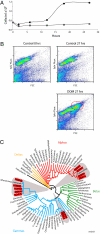Microbial community transcriptomes reveal microbes and metabolic pathways associated with dissolved organic matter turnover in the sea
- PMID: 20807744
- PMCID: PMC2944720
- DOI: 10.1073/pnas.1010732107
Microbial community transcriptomes reveal microbes and metabolic pathways associated with dissolved organic matter turnover in the sea
Abstract
Marine dissolved organic matter (DOM) contains as much carbon as the Earth's atmosphere, and represents a critical component of the global carbon cycle. To better define microbial processes and activities associated with marine DOM cycling, we analyzed genomic and transcriptional responses of microbial communities to high-molecular-weight DOM (HMWDOM) addition. The cell density in the unamended control remained constant, with very few transcript categories exhibiting significant differences over time. In contrast, the DOM-amended microcosm doubled in cell numbers over 27 h, and a variety of HMWDOM-stimulated transcripts from different taxa were observed at all time points measured relative to the control. Transcripts significantly enriched in the HMWDOM treatment included those associated with two-component sensor systems, phosphate and nitrogen assimilation, chemotaxis, and motility. Transcripts from Idiomarina and Alteromonas spp., the most highly represented taxa at the early time points, included those encoding TonB-associated transporters, nitrogen assimilation genes, fatty acid catabolism genes, and TCA cycle enzymes. At the final time point, Methylophaga rRNA and non-rRNA transcripts dominated the HMWDOM-amended microcosm, and included gene transcripts associated with both assimilatory and dissimilatory single-carbon compound utilization. The data indicated specific resource partitioning of DOM by different bacterial species, which results in a temporal succession of taxa, metabolic pathways, and chemical transformations associated with HMWDOM turnover. These findings suggest that coordinated, cooperative activities of a variety of bacterial "specialists" may be critical in the cycling of marine DOM, emphasizing the importance of microbial community dynamics in the global carbon cycle.
Conflict of interest statement
The authors declare no conflict of interest.
Figures



References
-
- Hedges JI. Global biogeochemical cycles: Progress and problems. Mar Chem. 1992;39:67–93.
-
- Ogawa H, Amagai Y, Koike I, Kaiser K, Benner R. Production of refractory dissolved organic matter by bacteria. Science. 2001;292:917–920. - PubMed
-
- Pomeroy LR. Oceans food web, a changing paradigm. Bioscience. 1974;24:499–504.
-
- Azam F, et al. The ecological role of water-column microbes in the sea. Mar Ecol Prog Ser. 1983;10:257–263.
-
- Azam F. Microbial control of oceanic carbon flux: The plot thickens. Science. 1998;280:694–696.
Publication types
MeSH terms
Substances
Associated data
- Actions
- Actions
- Actions
- Actions
- Actions
- Actions
- Actions
- Actions
- Actions
- Actions
- Actions
LinkOut - more resources
Full Text Sources
Other Literature Sources
Molecular Biology Databases
Miscellaneous

